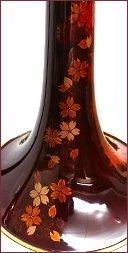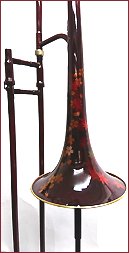Urushi -or Japanese lacquer- a natural tree resin tapped from the indigenous species toxicodendron vernicifluüm. The lacquer is a 100% natural material that doesn’t require the use of chemicals to obtain a beautiful finish. Archeological excavations have proven that its tradition and application goes back more than 12000 years. It was used in the Jomon period to repair and finish pottery, as well as decorate a wide range of ritual items like combs, caskets and baskets. The lacquer is tapped from the trees and applied in many layers of coating in order to obtain a perfectly smooth finish which -unlike synthetics- is warm to the touch. Even after 12000 years, scientists and industry have found no way to mechanize the application of natural lacquer and its craftsmen still use the same painstaking manual process that was first invented in the Jomon period.
Since the beginning of Japan’s Nara period, a wide range of decorative techniques have been introduced to lacquer craft. One of the most recognizable techniques which is exclusive to Japan, is maki-e. In the maki-e technique, small grains and shards of gold and silver are sprinkled into the uncured lacquer. Maki-e developed over the Heian and Edo period to create many of Japan’s national treasures. It is a technique which requires years of experience to master and will provide every item with a uniquely Japanese flair.
Since the beginning of Japan’s Nara period, a wide range of decorative techniques have been introduced to lacquer craft. One of the most recognizable techniques which is exclusive to Japan, is maki-e. In the maki-e technique, small grains and shards of gold and silver are sprinkled into the uncured lacquer. Maki-e developed over the Heian and Edo period to create many of Japan’s national treasures. It is a technique which requires years of experience to master and will provide every item with a uniquely Japanese flair.
Lacquer craft is suffering from the modern economical climate and fierce competition from synthetics. For example, the number of lacquer harvesters in northern Japan have dwindled from 300 in the pre-war period to only 20 people today. Lacquering by hand is a time consuming process that is very demanding on the craftsman. It is hard for them to make a living out of their art form. Younger generations of Japanese consumers are no longer familiar with natural materials or how they can adopt lacquered items into their daily lives. Therefore, our custom instrument lacquering service was started in order to promote the beauty of lacquer and to help revitalize Japan’s lacquer craft. Our first project was a lacquered trombone. Both the player and the lacquer craftsman were so pleased about final result, that we have been offering our service to a wider range of customers in Japan and are now expanding our business for clients outside Japan.
We offer a lacquering and maki-e decoration service entirely customized to the client’s wishes. Customers can contact us by email to discuss ideas about the colour coating and maki-e decorations on their instrument. Once all parties come to an agreement about the design and price, the instrument can be shipped to Japan and delivered to our specialist craftsmen. A partial advance payment may be required. Pictures will be sent to the client during the work in progress and the final result. After the full payment has been received, the item will be shipped back to the client. Our aim is to provide you with a unique looking instrument with the highest level of Japanese lacquer craft skill.
‘Can you lacquer any instrument?’
We can lacquer most instruments that are made out of wood, metal, bamboo, synthetic or ceramic material. However, we do not recommend using lacquer on instruments which use leather. Please contact us to discuss the possibilities.
‘Which colours are available?’
Japanese lacquer traditionally comes in shades of red and black. However, a new range of modern pigments allows us to finish the instrument in almost every imaginable colour
We can lacquer most instruments that are made out of wood, metal, bamboo, synthetic or ceramic material. However, we do not recommend using lacquer on instruments which use leather. Please contact us to discuss the possibilities.
‘Which colours are available?’
Japanese lacquer traditionally comes in shades of red and black. However, a new range of modern pigments allows us to finish the instrument in almost every imaginable colour



‘Can you give an indication about the price?’
Of course, the price will depend on the size and complexity of the instrument in question, as well as the number of the decorations in maki-e. However, to give you some impression about the price, please take 200.000 Yen (USD 1800) as a reference for the trombone pictured on this webpage. This includes the basic coating and decoration with cherry blossoms.
Of course, the price will depend on the size and complexity of the instrument in question, as well as the number of the decorations in maki-e. However, to give you some impression about the price, please take 200.000 Yen (USD 1800) as a reference for the trombone pictured on this webpage. This includes the basic coating and decoration with cherry blossoms.
‘Will the lacquer affect the sound of my instrument?’
There is no easy answer to this question. It depends hugely on the type of instrument and the base material. Some people have not noticed any noticeable change in the tone of their instrument, while others have noticed their instrument sounding slightly more round or sharp. Of course, we aim to lacquer your instrument in such a way that the tone will be affected as little as possible. Resonating areas of wooden instruments will be lacquered thinly in order to minimize affecting the tone. As a general rule, we always try to provide the client with honest information before commencing the lacquering process. However, please note that we cannot take any responsibility for any tonal change in the instrument once both parties have come to an agreement to lacquer the instrument.
There is no easy answer to this question. It depends hugely on the type of instrument and the base material. Some people have not noticed any noticeable change in the tone of their instrument, while others have noticed their instrument sounding slightly more round or sharp. Of course, we aim to lacquer your instrument in such a way that the tone will be affected as little as possible. Resonating areas of wooden instruments will be lacquered thinly in order to minimize affecting the tone. As a general rule, we always try to provide the client with honest information before commencing the lacquering process. However, please note that we cannot take any responsibility for any tonal change in the instrument once both parties have come to an agreement to lacquer the instrument.
Will the lacquer affect the playability of my instrument?
Generally, no. Our experience has taught us not to lacquer the moving parts of the instrument which can affect the playability. Again, this depends on the type of instrument. This will always be discussed with the client before applying the lacquer.
Generally, no. Our experience has taught us not to lacquer the moving parts of the instrument which can affect the playability. Again, this depends on the type of instrument. This will always be discussed with the client before applying the lacquer.
- Please inquire from [ info@edoshikki.com ] .
- We will discuss you about Delivery date,Estimate, Picture pattern.
- We will ship the instrument once we confirm payment.
- Please select a payment method. ① credit card ② Postal transfer ③ Bank transfer
- We will send it when finished.




| 3月 営業日 | ||||||
|---|---|---|---|---|---|---|
| 日 | 月 | 火 | 水 | 木 | 金 | 土 |
| 1 | 2 | |||||
| 3 | 4 | 5 | 6 | 7 | 8 | 9 |
| 10 | 11 | 12 | 13 | 14 | 15 | 16 |
| 17 | 18 | 19 | 20 | 21 | 22 | 23 |
| 24 | 25 | 26 | 27 | 28 | 29 | 30 |
| 31 | ||||||
| ※■印はお休みです。 | ||||||
| 4月 営業日 | ||||||
|---|---|---|---|---|---|---|
| 日 | 月 | 火 | 水 | 木 | 金 | 土 |
| 1 | 2 | 3 | 4 | 5 | 6 | |
| 7 | 8 | 9 | 10 | 11 | 12 | 13 |
| 14 | 15 | 16 | 17 | 18 | 19 | 20 |
| 21 | 22 | 23 | 24 | 25 | 26 | 27 |
| 28 | 29 | 30 | ||||
| ※■印はお休みです。 | ||||||
























